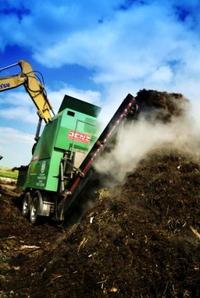How Organic Compost Is Made
Ever Wondered What Happens to Your Garden Waste?
Your everyday garden cuttings can be recycled into a quality organic compost which is full of essential plant nutrients.
So how is my garden waste recycled?
Garden waste such as grass cuttings, leaves and prunings can either be recycled in the garden at home in a compost bin or if you put them in your council collected garden waste recycling bin the chances are they will be recycled by a commercial composting facility.
The Commercial Composting Process
All garden and botanical waste that arrives at a composting facility is first of all graded, any large woody material (such as large logs) are removed and separately processed into bio-fuel for wood burning power stations. 
Once the material has been shredded and had any contaminants removed it is then formed into large prism shaped piles known an windrows this is when the composting process really begins. Below is the process that the material goes through to meet BS:PAS100 standards, the British Standard for quality compost.
There are three main phases of composting:
1) The Sanitisation Phase (Weeks 1 & 2)
2) The Stabilisation Phase (weeks 3 to 12)
3) The Maturation Phase (weeks 13 to 16)
1) Sanitisation - high temperature must be maintained to kill off weed seed and pathogens.
The material now begins to heat up naturally as it begins to compost, at this point the composter will monitor the temperature and moisturer content of the composting material everyday. During this phase the temperature of the compost must be kept over 65 degrees Centigrade for a minimum of 7 consecutive days. The heat is generated by the microbes and Bactria that break the garden waste down, in the first two weeks of composting the temperature can reach an amazing 70 to 80 degrees Centigrade!
The compost is also turned at least two times during this phase because we must maintain aerobic decomposition through out the windrow.
There are three things that are required to compost the material effectively: Moisture, Air (oxygen) and Heat.
The most important of which is Air, without air the Bactria and microbes can not reproduce or live and with out the Bactria breeding and living the temperature will not build up and the material will not be broken down. This is why the compost is turned every week to reintroduce air into the windrows and to ensure that all the composting material is broken down at the same rate.
2) Stabilisation Phase - a further 10 weeks of actively managed composting, temperature maintained at >55 degrees C.
The composter will continue to monitor the temperature and moisture levels of the composting windrows once a week during this phase. The compost is also turned at least 6 more times. After a minimum period of 12 weeks of composting , turning and monitoring, the compost is ready for screening to remove all the uncomposted oversize fraction.
The compost is screened to various grades depending on the final use or application of the compost.
3) Maturation
After screening the compost is stored in stock piles where it matures for a further four weeks before it can be used to fertilise gardens and farmers fields across the country.
What Can You Use Organic Compost For:
This compost is used in many applications in agriculture, horticulture and landscaping, it can be blended into topsoils to improve fertility and structure, used as a soil improver, mulch, speeds up turf establishment and is perfect for planting trees and shrubs as well as being added to other componenets to make peat free composts.
Find out more about the Benefits of Peat Free Organic Compost